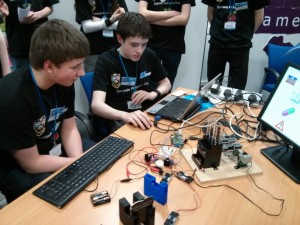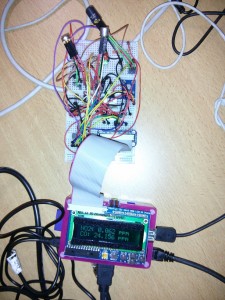| A few months ago PA Consulting Group ran a competition that challenged young people to make the world a better place using a Raspberry Pi. Last Wednesday I went along to help judge the 14 teams who made it to the final. Walking into the presentation room there was a real creative buzz as the contestants set up their projects and carried out last minute tweaks. They were excited and nervous and proud to have made something both cool and useful. The room was suffused by the Essence of Awesome that I’d love to put in an atomiser and spray on people who proudly tell me that they don’t see the point of the Raspberry Pi. It was also great to see mixed and all-girl teams well represented and something that we need to see more of. The creative side of computing often gets overlooked but was very evident here. As well as writing code, the contestants had built mini wired-up houses; roving robots; prototypes from Lego; hacked an energy monitor; hooked up RFID sensors to time races and built lots of other practical computing stuff that we think is a powerful hook to get people into computing. Despite what Hollywood would have us believe, computing isn’t about millions of lines of scrolling, arcane code: it’s about concepts and ideas and it’s about solving problems. The fun bit for me is in taking an idea and making it real. What was once only in your head is now alive and kicking in the real world. Better still, you can easily share your creation with the rest of the world via the Net. It doesn’t get much better than that if you like making things. What all of the entries had in common was a useful idea plus a level of creativity that the Raspberry Pi always seems to encourage. The winners8-11 years The Richard Pate School who designed a system to help elderly or disabled people answer the door. A great idea that was well thought out and we were impressed by the teamwork. 12-16 years: Dalriada School with their web-controlled pill dispenser. We were impressed with the professional level of research and prototyping as well as the clever idea.  Dalriada School’s brilliant pill dispenser. Various prototypes (front) are made from Lego and 3d-printed. 16-18 years: Team Meteoros from Westminster School, whose AirPi gathers air quality data and provides a web interface for monitoring and analysis. The judges loved the teamwork, passion and the potential (each AirPi will feed information to a central server). It was my personal favourite: I'll be making one with my son to stick in our garden and will blog about this as we put it together. Full build instructions and how to get involved are on their site. Open category: UNOP who reverse-engineered the communication protocol of an off the shelf electricity monitor to make better use of the data. I loved the hacker ethos: “this doesn’t do what I want it to so I’m going to make it better.” These projects were a taster of exactly what the Raspberry Pi Foundation set out to do and we look forward to see more and more of this as people get a chance to mess about on an open and accessible platform. We want what was happening in that room to start happening in schools and clubs and homes everywhere. So congratulations to the winners, thanks again to PA Consulting for running a quite brilliant competition and a special thanks to all of the young people who showed us yet again that given the opportunity and a Raspberry Pi they will surprise us with their ideas, creativity and tech skills. It was a pleasure to be there. N.B. I have used the words ‘creative’ and ‘creativity’ a lot. I make no apologies. Get a Raspberry Pi. Get creating. I’m off to pitch Essence of Awesome™ to Chanel. |
A Semi-automated Technology Roundup Provided by Linebaugh Public Library IT Staff | techblog.linebaugh.org
Saturday, March 23, 2013
Raspberry Pi Competition Results
Rumor: New Samsung Galaxy Tab 3 Plus Tablet to Feature a HD AMOLED Display
| We already know Samsung is reported to launch the Galaxy Tab 3 at the IFA event in September, though new input from SamMobile further whets our appetite with reports of there being a high end tablet in the making as well. The new tablet, dubbed Galaxy Tab 3 Plus, is likely to sport a 10.1 inch display, though it could even be as big as 11.6 inches. However, the screen dimension apart, the real treat could the the display, as unconfirmed but reliable sources point out the new tablet could feature a High Definition Super AMOLED display. The same sources also state the tablet will be built around the 5th generation octa core Exynos chip, which is likely to power it with enough horsepower to be pitted against the likes of the Apple iPad. The latter is also slated to launch its 5th gen iPad during June or thereabouts. The best tablet Samsung now offers in the 10 inch category is the Nexus 10, which blows away the competition with its performance and range topping display. However, only the the Galaxy Tab 7.7 comes with an AMOLED display, which has already impressed with its deep black and colors that are rich and vivid. Watch this space for more updates as it becomes available.
Rumor: New Samsung Galaxy Tab 3 Plus Tablet to Feature a HD AMOLED Display is a post from: E-Reader News |
The $35 Aakash Tablet Faces Uncertain Future
| The Aakash tablet, which had shot to instant stardom in the world tech scene owing to its down-to-earth price, now faces an uncertain future. In fact, the entire project runs the risk of being scrapped altogether as the present Human Resource Development Minister feels the system has become obsessive with a single device when the focus should be to enable the students have easy access to quality educational content at all levels. What has added to the woes of the HRD team is that Datawind has failed to deliver the tablet in adequate numbers. The Canadian firm was contracted to deliver 100k of the Aakash tablet by the 31st of March, but has only managed to deliver 20k so far. “Aakash is only a tablet… there are other such devices as well. While work will continue to develop it and increase its productivity, manufacturing is obviously a problem,” said Pallam Raju who has replaced Kapil Sibal has the HRD Minister just a few months ago. The ministry is also holding back on issuing a fresh tender to procure 5 million of the Aakash tablets. Instead, it has constituted two independent committees to review the Aakash project and its fate depends on what the committees conclude. As per initial plans, the government was obliged to provide students the Aakash tablet at about ₹ 1,130, which involved a 50 percent government subsidy. That does not seem to be the case anymore as producing a large number of tablets seems to be a bigger challenge than designing it. In any case, the Aakash tablet has managed to evoke awareness among the masses about the critical importance of having access to the right information at the right time. “Aakash is a tablet which will enable you to access the content. But there are others who have come up…students will pick up whatever serves the purpose better and affordable. We will continue to work on the product as long as development of the product is concerned,” stated the HRD minister. The Aakash project has been fraught with delays and controversies right from the start and the project might have to be downsized, if not scrapped altogether.
The $35 Aakash Tablet Faces Uncertain Future is a post from: E-Reader News |
New Archos Titanium and GamePad Tablets Now on Sale in the US, Prices Start $169
| Archos has made available its latest tablets in the US, which includes the GamePad, the Archos 80 Titanium, and the Archos 97 Titanium. The GamePad is the smallest of the lot with a 7 inch display and is designed for the niche segment of gaming. Towards that, the tablet has also been provided with the full gaming controls to allow for a rich gaming experience, while its behind the shell features comprise of a 1 GHz dual core chip along with a 1 GB RAM. The GamePad features a 1024 x 600 pixel display and runs Android Jelly Bean. The tablet commands a rather tempting $179 price tag. Coming to the Titanium offerings, the 80 Titanium comes with a 8 inch 1024 x 768 pixel display, though the real attraction here is the 97 Titanium device that offers a 2048 x 1536 pixel Retina display. This apart, both the Titanium siblings are pretty much the same on the spec front. Both are powered by a 1.6 GHz dual core chip and 1 GB of RAM, as well as containing 8 GB of on-board storage and an option for a microSD card. The two Titanium tablets also run Android Jelly Bean. Price wise, the 80 Titanium is the cheapest at $169 while the 97 Titanium boasts of a modest price tag of $249. The tablets can be picked up from retailers such as Amazon, B&H Photo, J&R, Brandsmart, Hastings, Beach Camera, and Adorama in the US.
New Archos Titanium and GamePad Tablets Now on Sale in the US, Prices Start $169 is a post from: E-Reader News |
Archos 97 Titanium HD and Archos 80 Bring iPad-style Screens to Android for Half the Price
| Archos is one of the more prolific budget tablet makers, and they recently unveiled their new line of “Titanium” tablets, and now a couple of models have started showing up for sale, both of which just happen to have the same screen size and resolution as the iPad 4 and iPad Mini, and they sell [...] |
URL: http://feeds.the-ebook-reader.com/~r/feedburner/cmWU/~3/c7Jy_PPfvhc/
San Diego schoolkids and Raspberry Pi
| I was sent some video yesterday from Chris Rosskopf, a teacher at High Tech Media Arts in San Diego, California. For one week a year, High Tech High Media Arts suspends its regular classes in order to offer a more focused, intensive week of study in an area outside the normal curriculum. For this particular project, a group of students chose to build and experiment with Raspberry Pi computers. Here’s what they thought of the Pi and what it might mean for them. We loved this; it’s great to watch kids catch on to what we’re trying to do at the Foundation. |



